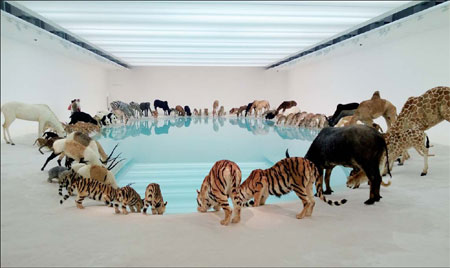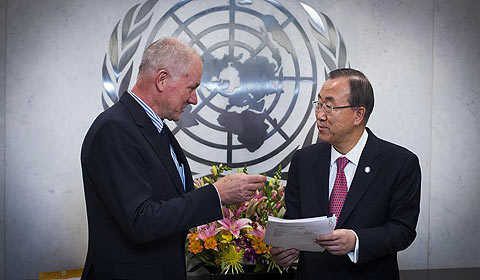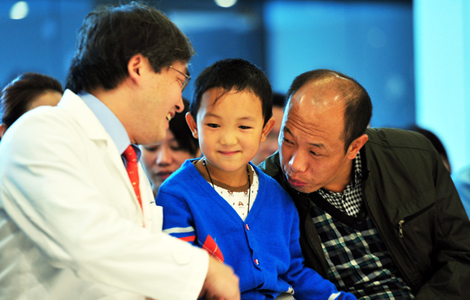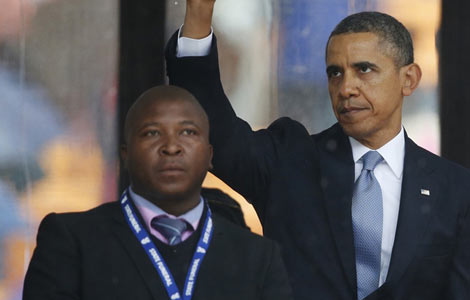
An artist with a sense of explosive drama grasps the power of introspection for his current exhibition
Even without his usual gunpowder and explosions, artist Cai Guo-Qiang has the power to wow viewers with his poetic and serene installations in his first solo exhibition in Australia. His exhibition Falling Back to Earth, which opened at the Gallery of Modern Art in Brisbane in mid-November, shows the artist's shift toward a more grounded engagement. Cai's two commissioned installations, Heritage and Eucalyptus, both monumental in scale and with strong visual impact, feature motifs drawn from the natural world.
"They represent my childlike innocence but also convey solemnity, confusion and reflection of the real world," explains Cai, who has painted the sky full of smoke and flames in his art projects across the world.
Speaking in Mandarin with the strong accent of his native Fujian province, the New York-based artist looks fitter and younger than his mid-50s.
Though he has lived in the United States since 1995, Cai talks with the Western media mostly through an interpreter. With many of his works creating a dialogue between the East and the West, Cai says the language barrier has never been a problem for him.

The exhibition's centerpiece, the 1,100-square-meter Heritage, features 99 replicas of animals, including pandas, tigers, bears, and giraffes, lowering their heads to drink together from a water hole surrounded by white sand.
"This pristine environment embodies my perception of a last paradise, far from the cares and conflicts of the rest of the world, where people come from across the globe and share the same space," Cai says.
Yet, such a utopian vision is loaded with uncertainty, and there is something disquieting about the stillness.
If the room is quiet enough, visitors may be able to hear an incessant drip that breaks the surface of the water.
The artist says he tries to raise questions that activate this strange, peaceful tableau: What brings this menagerie together, and how can the predators and prey in this gathering relate to each other?
The title of the exhibition came from a fourth-century Chinese poem by Tao Yuanming (AD 365-427), Ah, Homeward Bound I Go.
"The poem captures the concept behind the exhibition and expresses the idea of going home, returning to the harmonious relationship between man and nature, and re-embracing the tranquility in the landscape," Cai says.
Russell Storer, curator of the exhibition, says Cai "always tries to make connections to the local context in which he makes his works".
While preparing for the solo exhibition, Cai visited Australia many times. His trip with his family in 2011 to Queensland, "where crystal-clear lakes shine like multi-hued gems", was particularly inspiring, he says.
"The experience of taking a walk in the forest at night looking for nocturnal creatures up in the trees, their eyes seemingly glowing in the dark, reflecting from the light of our head torches and learning about what they were. It was quite a magical experience," Cai recalls.
Eucalyptus, inspired by the ancient trees of Lamington National Park, creates a "meditative, immersive experience" for visitors, Storer says. A native eucalyptus, which was earmarked for clearing for an urban community development, has been relocated into the gallery.
"This is an unfinished artwork," Cai says. Viewers are invited to draw and write their ideas on the tree's past and future.
With the 31-meter tree, Cai references the Chinese scholarly tradition in which artists and poets would commune with nature to gain their moral and spiritual bearings, and represent the landscape as a reflection of their experiences and values.
Though his new artworks do not involve any fire explosions, Cai says there was still risk in the work.
"The biggest challenge is definitely the structure, engineering of the work. The 170 tons of water in the gallery is like a big time bomb," he says.
The replicas of the animals were all made in Quanzhou, Cai's hometown in Fujian province, which took more than six months. Other elements - the sand, the fabrication of the water hole and the entire water system - were all produced in Australia.
The exhibition, presented by Tourism and Events Queensland, runs until May 11, 2014. In addition to Heritage and Eucalyptus, it also features Head On, 99 replicas of wolves running in a high arc against a glass wall. Inspired by the Berlin Wall, it is an installation Cai created in 2006.
"Falling Back to Earth" is a significant evolution for Cai, says Chris Saines, director of the Brisbane gallery, which has a long-standing relationship with the artist.
Cai was featured in the gallery's Asia Pacific Triennial in 1996 and 1999. But neither of his projects was delivered as planned. The explosion project in 1996 was canceled because of an accident, and the 99 small boats filled with alcohol all sank to the bottom of the Brisbane River before appearing before viewers as a Blue Dragon in 1999.
Yet, the artist has not been deterred by these "failures" and is on his "unlimited exploration in the limited world".
The number 99 occurs frequently in Cai's works, like Heritage and Head On.
"Nine represents 'long-lasting' in Chinese numerology, while 99 suggests for me something that is not quite complete, providing a sense of insufficiency and expectation," Cai says.
oushuyi@chinadaily.com.cn

|
Cai Guoqiang shifts his focus from the universe and cosmos back to earth in his solo show in Australia. Top: Heritage is the centerpiece of the exhibition. Ou Shuyi / China Daily |
(China Daily Africa Weekly 12/13/2013 page29)








